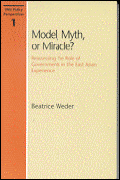Before the financial crisis of the late 1990s. the East Asian experience was hailed as a miracle and a model of successful development. A broad consensus had been reached on the role of governments in engineering this economic success, an rapid growth was generally attributed to sound policies that were underpinned by a solid institutional framework.
In the aftermath of the financial crisis, however, the “miracle” has been dismissed as a myth and a bad example that other countries should avoid. Critics allege that governments not only made serious policy mistakes, but also that the institutional framework was not so beneficial after all. The term “crony capitalism” is frequently used to summarize this notion.
This book investigates the role that institutional conditions played in the miracle, and whether they had a part in causing the crisis. The focus is on such factors as the close ties between the public and private sectors, the incentives structures within the public sector, and corruption.
Empirical tests show that these factors can indeed contribute to explaining differences in economic growth. The data also show that the notion of distinctive East Asian experience is misguided because there were always large differences in institutional conditions among the miracle economies. Scorecards of institutional performance are presented for Thailand, Malaysia, South Korea, Singapore, and Hong Kong
The volume ends with a detailed discussion of the role of corruption. The author concludes that, contrary to popular belief, there is no evidence of corruption having cased the crisis.
Authors
